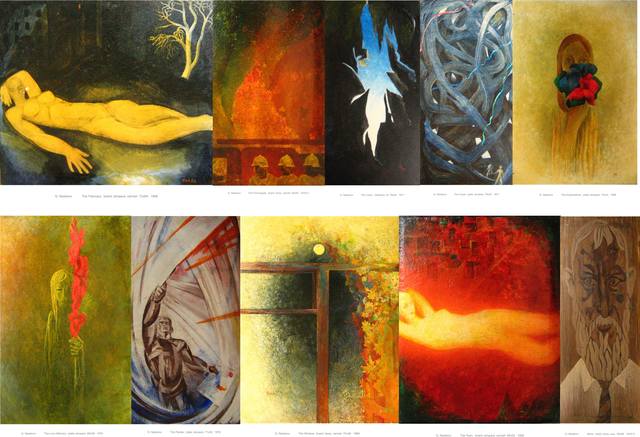"ВТОРОЙ АВАНГАРД" ГРИГОРИЯ НЕСТЕРОВА (Минск, 1960-е 1970-е)
"ВТОРОЙ АВАНГАРД" В МИНСКЕ (конец 60-х начало 70-х)
"Первый авангард" можно не любить, но не признавать его существование невозможно... Он отразил революционные настроения в мировом сообществе 1905-1914 годов... Через 60 лет эти настроения повторились. В революционный период 1965-1974 годов в Париже "студенческая революция", в США "негритянские бунты", в Китае "культурная революция", в Москве "диссиденты" и "бульдозерная выставка". В искусстве этого периода, получившем название "второго авангарда", Эти настроения ярки и своеобразны, несмотря на все сходство с авангардом "первым". В Белоруссии эти настроения, в эти же годы носили сходный характер, это не трудно заметить и на примере моего творчества... Эта стилистика была органична и своеобразна, ее можно тоже не любить, но отрицать ее своеобразие невозможно... Настроения общества меняются, а вместе с ними и форма творчества, стиль искусства и жизни. Нам нравится что-то другое... но, что-то появившееся однажды, из истории выбросить невозможно...
("Второй авангард" - термин М. Гробмана)
Из ретроспективной выставки в галерее "ДК" Минск, октябрь 2014
“THE SECOND AVANT-GARDE” BY GREGORY NESTEROV (Minsk, 1960-th 70-th)
"The first avant-garde" one can not love, but do not recognize its existence is impossible...
It reflected the revolutionary moods in the international community's 1905-1914...
After 60 years, these moods were repeated.
By the revolutionary period of 1965-1974 years: in Paris is "of the student revolution"; in the US "of the negro riots"; In China "the cultural revolution"; in Moscow are "the dissidents" and "of the Bulldozer Exhibition".
The art of this period was named as the "second avant-garde” (by M. Grobman).
These sentiments are bright and distinctive, despite all the similarities with the “avant-garde of the first".
In Belarus that moods in those years were similar, it is not difficult to see and by the example of my work...
This style was organic and original… It possible do not to love but impossible to deny its originality...
The moods of society have the change, and together with them and the forms of creativity, style, art and life.
We may like something else... but what appeared for us once in the history is impossible to throw out...
By the retrospective exhibition “Aspiration for Absolute” at the gallery "DK" (Minsk, October 2014) http://forum.artinvestment.ru/blog.php?b=277541
"Первый авангард" можно не любить, но не признавать его существование невозможно... Он отразил революционные настроения в мировом сообществе 1905-1914 годов... Через 60 лет эти настроения повторились. В революционный период 1965-1974 годов в Париже "студенческая революция", в США "негритянские бунты", в Китае "культурная революция", в Москве "диссиденты" и "бульдозерная выставка". В искусстве этого периода, получившем название "второго авангарда", Эти настроения ярки и своеобразны, несмотря на все сходство с авангардом "первым". В Белоруссии эти настроения, в эти же годы носили сходный характер, это не трудно заметить и на примере моего творчества... Эта стилистика была органична и своеобразна, ее можно тоже не любить, но отрицать ее своеобразие невозможно... Настроения общества меняются, а вместе с ними и форма творчества, стиль искусства и жизни. Нам нравится что-то другое... но, что-то появившееся однажды, из истории выбросить невозможно...
("Второй авангард" - термин М. Гробмана)
Из ретроспективной выставки в галерее "ДК" Минск, октябрь 2014
“THE SECOND AVANT-GARDE” BY GREGORY NESTEROV (Minsk, 1960-th 70-th)
"The first avant-garde" one can not love, but do not recognize its existence is impossible...
It reflected the revolutionary moods in the international community's 1905-1914...
After 60 years, these moods were repeated.
By the revolutionary period of 1965-1974 years: in Paris is "of the student revolution"; in the US "of the negro riots"; In China "the cultural revolution"; in Moscow are "the dissidents" and "of the Bulldozer Exhibition".
The art of this period was named as the "second avant-garde” (by M. Grobman).
These sentiments are bright and distinctive, despite all the similarities with the “avant-garde of the first".
In Belarus that moods in those years were similar, it is not difficult to see and by the example of my work...
This style was organic and original… It possible do not to love but impossible to deny its originality...
The moods of society have the change, and together with them and the forms of creativity, style, art and life.
We may like something else... but what appeared for us once in the history is impossible to throw out...
By the retrospective exhibition “Aspiration for Absolute” at the gallery "DK" (Minsk, October 2014) http://forum.artinvestment.ru/blog.php?b=277541
Всего комментариев 0






